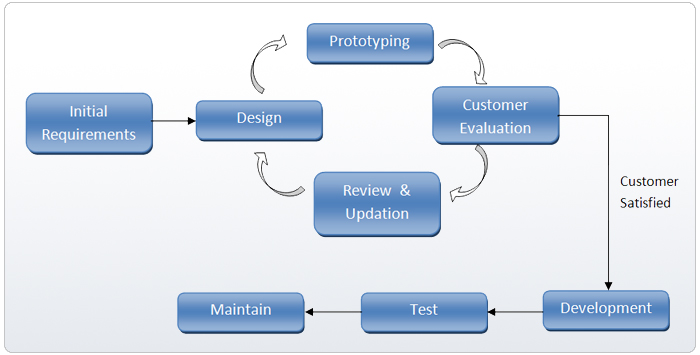RAD, Prototyping, Agile Development.
Prototyping:
Prototyping is creating the product but not fully finishing it - most elements will be contained in the software but some interface designs may be missing. the prototype is given to the client to test and bring back feedback on the product, this then gives an outline of problems and improvements the programmer needs to overcome. this method is very useful because it saves a lot of time since a product is being made straight away. on the other hand if the prototype hasn't been made very well then the product could take longer to fully finish as there will be more flaws that need improvement. the prototype will not be full working system so the client will only be able to see how buttons and pages are connected but would not work as a finished system.
there are two different methods of prototyping, evolutionary and throw away. evolutionary prototyping involves working on the customers feedback and improving and editing the system to meet the clients needs fully. Throw away prototyping involves working on small areas of the system then gaining feedback from the customer whether it works or not. the prototype is then discarded but the information gained from the prototype will be applied into the system when it is made.

Rapid Application Development:
RAD is a method used in order to speed up creating a system, this takes a less formal approach and works on 4 different ideas to make the software possible. the 4 steps to follow are:
1- using small focus groups to extract requirements for the system, this saves time from writing formal documents.
2- make prototypes to gain feedback from the client, this gives the programmer more detailed and precise information of the design of the system.
3- use strict time frames to create the system to a good, more flawless design.
4- re-use the software features that work, this saves time and allows the programmer to develop on from them.
there are few problems with the RAD method, the two biggest issues involve the input from clients and the time constraints set on development. input from clients can be an issue for RAD, if there are many users of the system then they may not all agree on the best type features for the system. users can all have different interests in how they think the system should run so gaining unanimous feedback improvements can become very difficult. also, the time constraints effect this too, if clients are taking too long to bring good feedback (or agree on the improvements they would like) then this could hold back further development of the system.
Agile Development:
Agile development involves working in 3 methods, incremental, iterative, and evolution. the team that are working the system break down the work into increments. this helps lower the amount of work that has to be done by the team. iterations are time frames that help the Agile developers make the system quicker and to time. after an iteration has been created it is given to the client to make feedback on, due to the fact that the work has been broken down into iterations it means that the work can be finished to a higher level; this helping the system have less flaws.

these methods help speed


Comments
Post a Comment